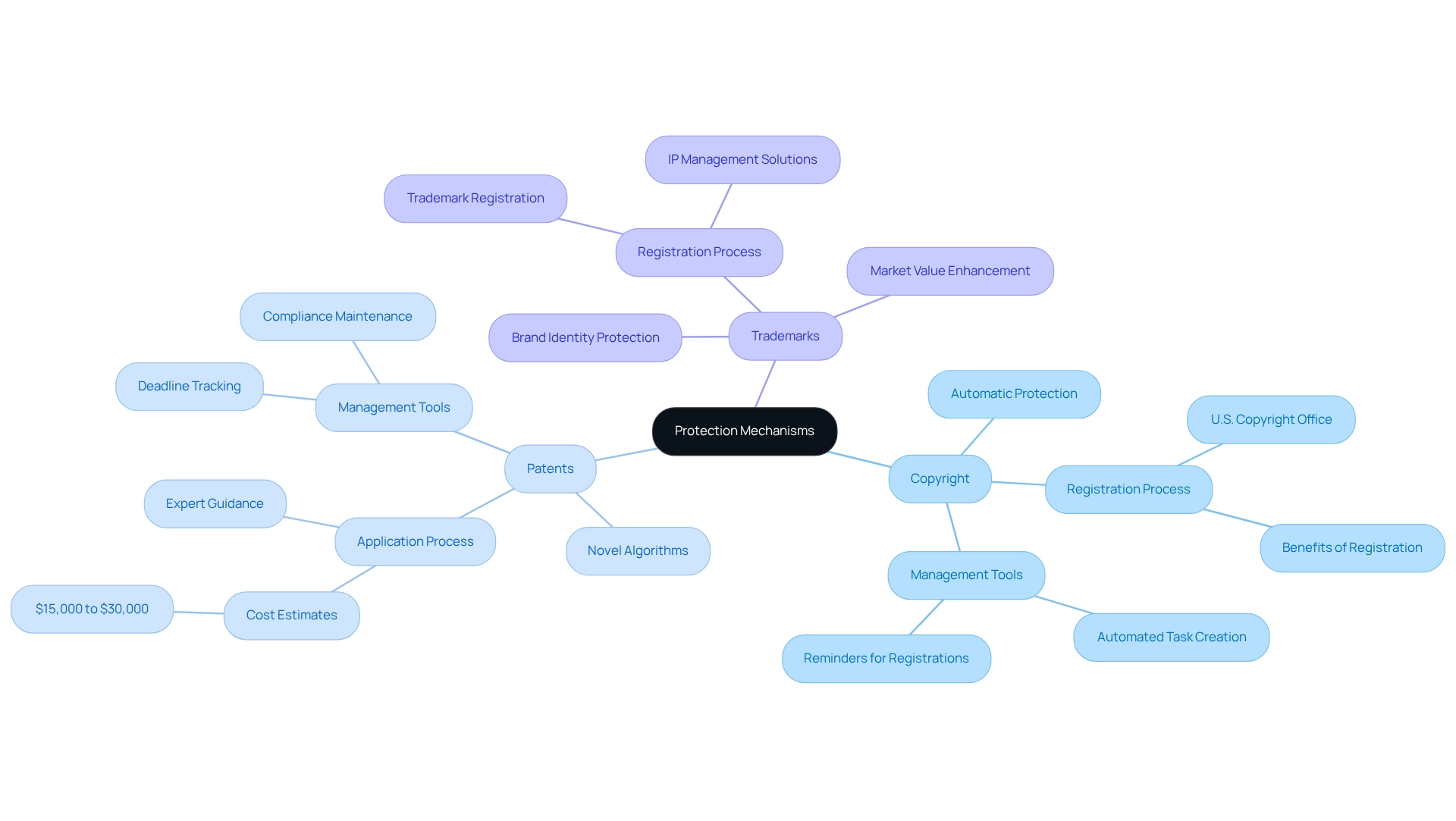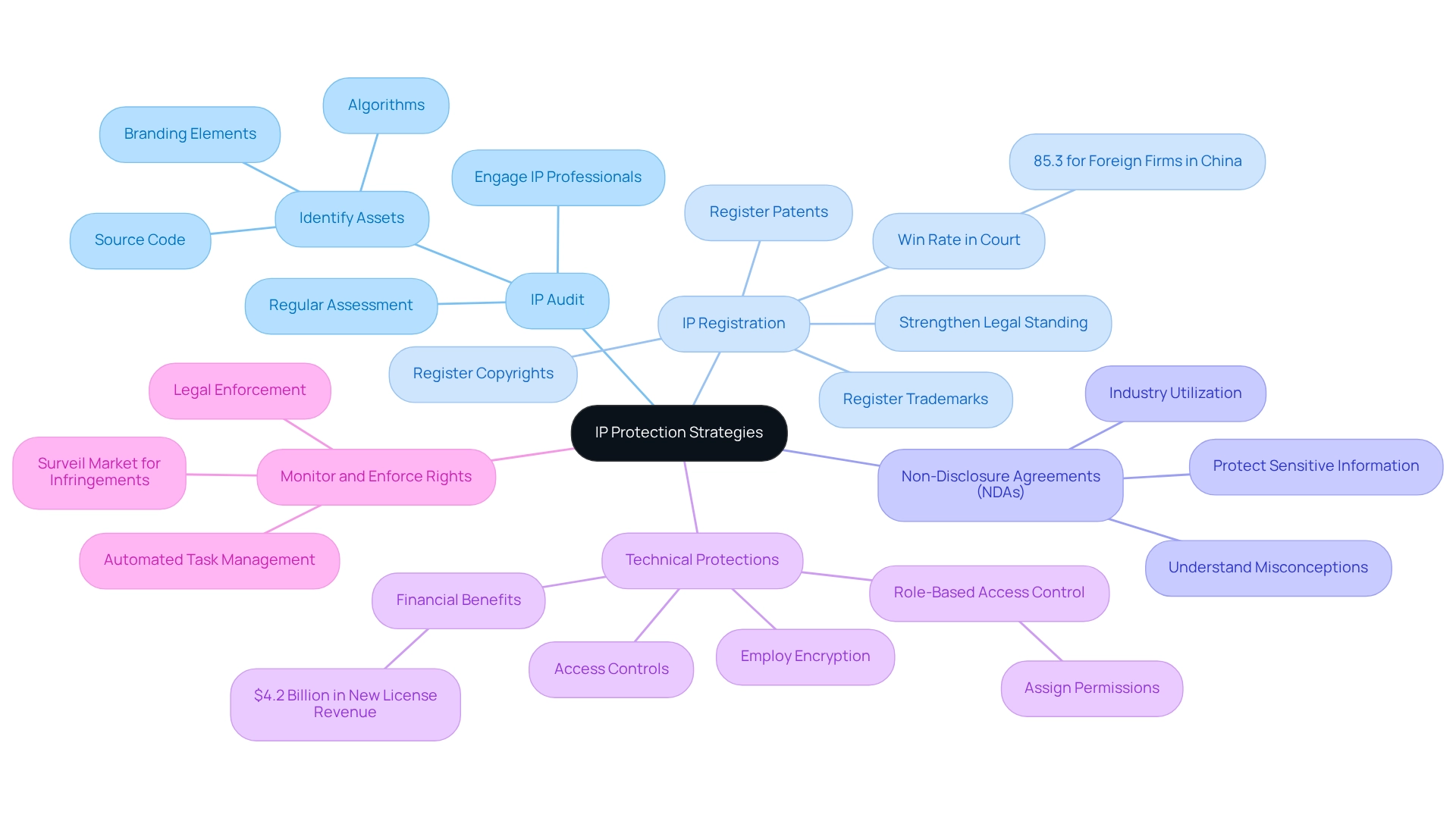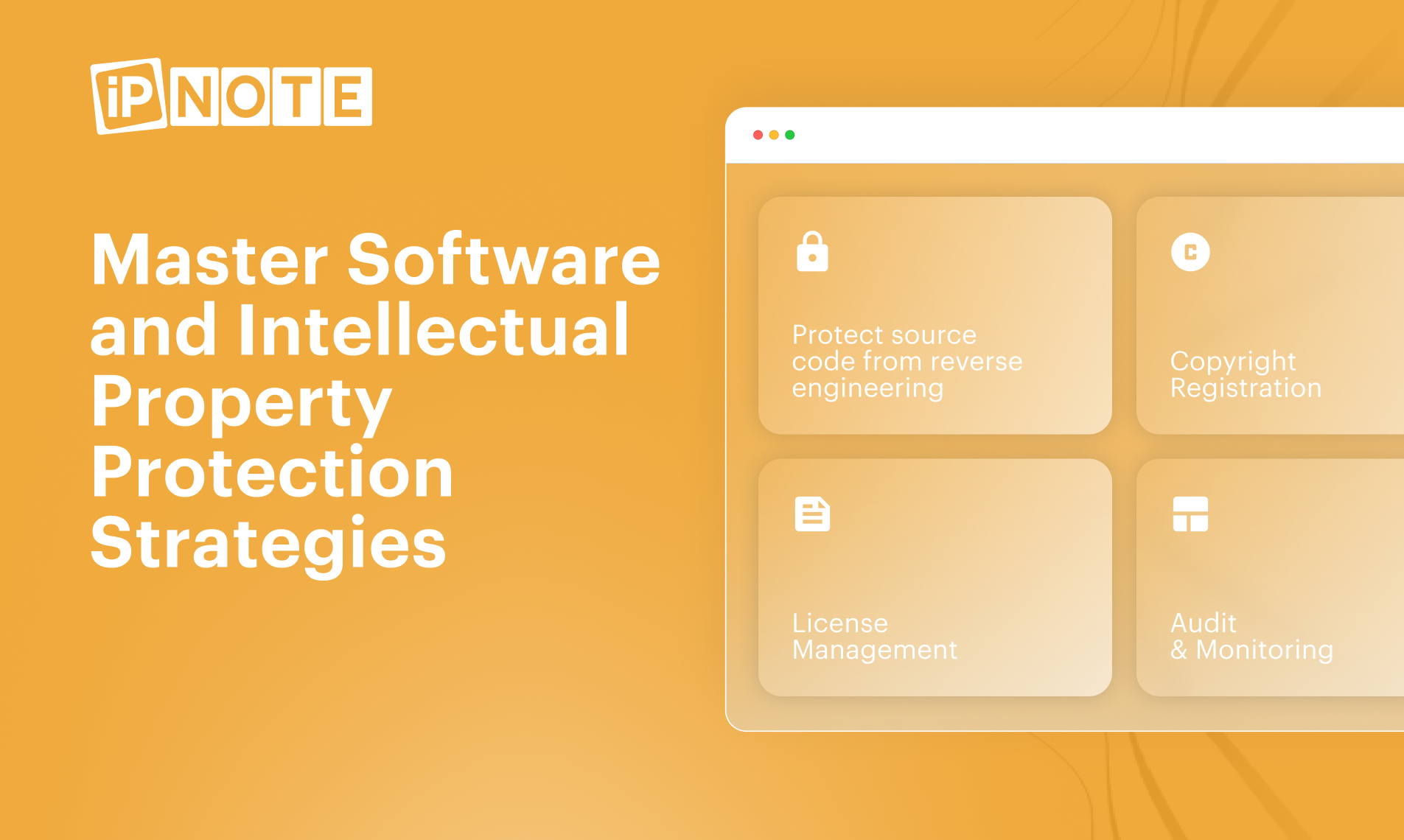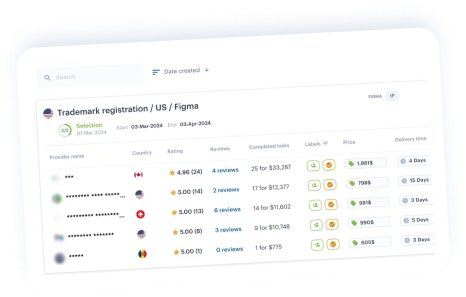Overview
Mastering software and intellectual property protection strategies is essential for safeguarding digital products. Key mechanisms, including copyrights, patents, and trademarks, play a crucial role in this process. A comprehensive understanding and implementation of these protections not only enhance legal standing and market competitiveness but also foster innovation. This is evidenced by the growing number of registrations and applications in the tech sector. By prioritizing effective IP management, organizations can navigate the complexities of the digital landscape with confidence.
Introduction
In the rapidly evolving landscape of the software industry, the protection of intellectual property (IP) is of paramount importance. As innovations emerge at an unprecedented pace, it is essential for developers and companies alike to grasp the nuances of IP rights—spanning copyrights, patents, and trademarks. With high stakes and the looming potential for infringement, organizations must adeptly navigate a complex web of legal frameworks to safeguard their creations.
This article explores the intricacies of IP protection mechanisms, providing valuable insights into effective strategies that empower software companies to defend their innovations and enhance their competitive edge in a crowded market. Through a comprehensive examination of challenges and solutions, it becomes evident that robust IP management is not merely a legal necessity; it is a strategic advantage in today’s digital economy.
Understand Intellectual Property and Software Rights
Intellectual property (IP) encompasses the creations of the mind, including inventions, literary and artistic works, designs, and symbols. In the technology sector, the protection of software and intellectual property rights plays a crucial role in safeguarding the unique elements of digital products, such as source code, algorithms, and user interfaces. The primary categories of IP relevant to applications include:
- Copyright: This safeguards the expression of ideas within code, granting creators exclusive rights to reproduce, distribute, and modify their work. By 2025, the significance of copyright in the safeguarding of programs is underscored by the rising number of copyright registrations, indicating a growing awareness among developers of their rights.
- Patents: These defend inventions and processes, including algorithms that provide new and useful functions. The trend of patent applications in the software sector has experienced substantial growth, with prominent firms establishing benchmarks in international patent filings, demonstrating their dedication to innovation and IP protection. Notably, the USPTO reports that first office actions are issued within an average of 16.5 months, highlighting the timeline that companies must navigate in the patent application process. iPNOTE enhances this process by providing a comprehensive AI-driven platform that allows corporate IP managers to track progress and manage connections with various IP rights seamlessly. The platform is designed to be foolproof, guaranteeing that users can navigate their entire portfolio safely and effectively.
- Trademarks: These protect brand names, logos, and slogans related to applications, ensuring brand identity and consumer recognition. As of 2021, an astonishing 13.9 million trademark applications were submitted worldwide, highlighting the competitive environment in which developers operate. This high volume of applications suggests a strong market where innovation and brand differentiation in software and intellectual property are vital for success. Experts emphasize that a solid grasp of software and intellectual property rights not only fosters innovation but also improves a company’s competitive edge in the market. Recent statistics from the International Intellectual Property Index 2025 indicate that nations with strong IP frameworks experience greater levels of application development and investment, further highlighting the essential nature of IP rights in the technology sector. Particular insights from this index suggest that robust IP safeguards are linked to industry expansion, a principle that iPNOTE exemplifies through its dedication to trustworthy data security and access management in its AI-driven IP management platform.
Explore Protection Mechanisms: Copyrights, Patents, and Trademarks
To effectively safeguard your application, understanding the various protection mechanisms available is crucial:
- Copyright: Copyright protection automatically applies to original code upon its creation. Registering your program with the U.S. Copyright Office solidifies your legal standing and enhances enforcement against infringement. Automated task creation and reminders can assist you in managing copyright registrations effectively, ensuring your software is safeguarded against piracy.
- Patents: If your software incorporates a novel algorithm or method, seeking a patent is recommended. The patent application process can be intricate and costly—averaging around $15,000 to $30,000 in 2025—but it provides robust protection against competitors. Management tools can help track deadlines and maintain compliance throughout the patent application process. Recent changes in patent laws emphasize the need for clarity in patenting algorithms, making expert guidance essential.
- Trademarks: Protecting your program’s name and logo through trademark registration is vital for maintaining brand identity. This not only prevents others from using similar marks but also enhances your brand’s market value. Extensive IP management solutions can simplify the trademark registration process, guaranteeing your brand remains safeguarded in a competitive environment.
Each of these methods serves a unique function and can be strategically integrated to ensure thorough security for your applications. Utilizing iPNOTE’s AI-powered IP management solutions can significantly decrease management expenses and automate tasks associated with your IP portfolio, allowing you to concentrate on innovation while establishing strong strategies. Furthermore, understanding the factors leading to elevated levels of piracy in developing nations—such as restricted access to affordable, legitimate applications and weak enforcement of intellectual property rights—highlights the importance of robust IP safeguarding strategies.

Implement Effective Strategies for IP Protection
To effectively protect your software and intellectual property in the tech industry, consider implementing the following strategies:
- Conduct an IP Audit: Regularly assess your programs and associated assets to identify what needs safeguarding. This includes source code, algorithms, and branding elements. Engaging with experienced IP professionals can help ensure compliance with relevant laws during audits, particularly in complex jurisdictions. Navigating the legal landscape for IP can be intricate, making professional guidance essential.
- Register Your IP: Ensure that copyrights, patents, and trademarks are formally registered. This not only strengthens your legal standing in disputes but also enhances your ability to monetize your IP effectively. Significantly, foreign technology firms in China have attained an impressive 85.3% win rate in court, underscoring the importance of strong registration.
- Utilize Non-Disclosure Agreements (NDAs): When sharing your application with potential partners or employees, NDAs are crucial for protecting sensitive information and trade secrets. It’s essential to understand common misconceptions about NDAs, as these can undermine their effectiveness. A significant percentage of technology firms are expected to utilize NDAs for IP protection, emphasizing their importance in the industry.
- Implement Technical Protections: Employ encryption, access controls, and other technical measures to shield your software from unauthorized access and piracy. iPNOTE’s role-based access control allows you to assign specific permissions, ensuring that sensitive data is only accessible to authorized personnel. These proactive steps are vital in an era where compliance intelligence has generated over $4.2 billion in new license revenue since 2010, illustrating the financial benefits of robust protection for software and intellectual property. By implementing these technical measures, businesses can further enhance their IP security and capitalize on the revenue opportunities that arise from compliance.
- Monitor and Enforce Your Rights: Actively surveil the market for potential infringements and be prepared to enforce your rights through legal channels if necessary. This vigilance is critical in maintaining the integrity of your intellectual property. Employing iPNOTE’s automated task management capabilities can simplify the process of overseeing and handling your IP portfolio, ensuring that you remain proactive against potential threats.
By implementing these strategies, you can create a thorough framework for safeguarding your intellectual property, ensuring its worth is maintained and improved in the competitive environment of 2025.

Troubleshoot Common IP Management Challenges
Handling software and intellectual property presents various obstacles for technology firms. Here are some prevalent issues and strategies to effectively address them:
- Complexity of IP Laws: The intricacies of IP laws can vary significantly across jurisdictions, making compliance a daunting task. Hiring an IP attorney with expertise in technology can provide crucial advice, ensuring that your company navigates these challenges efficiently and secures robust protection for its innovations. The platform simplifies this process, offering an efficient way to connect with qualified IP attorneys, thereby enhancing your compliance efforts. For instance, clients in the USA have reported a 7x return on investment in the number of deals facilitated through the platform’s services.
- Infringement Risks: The digital landscape exposes applications to piracy and unauthorized use, with statistics indicating that piracy remains a critical issue, adversely affecting revenue and market integrity. The gaming market, projected to surpass $180 billion in revenue this year, underscores the significant value at risk. Implementing advanced monitoring tools can help detect potential infringements early, allowing for prompt action to mitigate risks and protect your software and intellectual property. Notably, the most pirated software includes Windows (XP, 7, and 10), as highlighted by GO-Gulf, emphasizing the vulnerabilities software companies face. The effective advertising strategies and SEO optimization employed by the company have enabled clients to achieve substantial returns on investment, showcasing its ability to attract clients even in highly specialized markets, as illustrated in case studies from South Korea.
- Cost of Protection: The financial burden of registering and enforcing IP rights can be considerable. It is essential to budget for these expenses and consider cost-effective strategies, such as utilizing open-source licenses when appropriate, to enhance protection without incurring excessive costs. The Prime Ultra plan from iPNOTE offers a comprehensive business solution package that guarantees a 3x increase in customer acquisition through tailored marketing strategies, significantly reducing overall costs associated with IP management. Clients have reported that this plan not only bolsters their market presence but also reduces their commission rates from 15% to 7.5% for incoming tasks.
- Keeping Up with Changes: The rapid evolution of technology necessitates continuous updates to IP laws and regulations. Staying informed about these changes is vital; subscribing to legal updates and participating in industry forums can provide valuable insights into how new laws may impact your applications. Moreover, the BSA states that businesses in the U.S. may incur penalties of up to $150,000 for each instance of pirated applications, underscoring the seriousness of licensing infringements. iPNOTE’s personalized promotion strategy assists businesses in better positioning themselves in the market, ensuring they remain compliant and informed about the latest developments in software and intellectual property. By proactively addressing these challenges in software and intellectual property, software companies can fortify their IP management strategies and safeguard their innovations against infringement, leveraging the proven success strategies and client testimonials associated with iPNOTE.
Conclusion
In the software industry, safeguarding intellectual property (IP) is not merely a legal obligation; it is a strategic imperative. Understanding the various forms of IP—copyrights, patents, and trademarks—is essential for developers and organizations aiming to protect their innovations.
Copyright protects original software code, while patents secure novel algorithms and processes. Trademarks, conversely, safeguard brand identity, which is vital in a competitive market. Each of these mechanisms serves a unique purpose and, when effectively combined, offers comprehensive protection for software innovations.
Implementing robust strategies for IP protection is crucial. Regular IP audits, formal registrations, and the use of non-disclosure agreements significantly enhance legal standing and protect sensitive information. Furthermore, employing technical protections and actively monitoring for infringements are proactive measures that ensure the integrity of intellectual property. By leveraging tools such as iPNOTE, software companies can navigate the complexities of IP management more efficiently, allowing them to focus on innovation while safeguarding their assets.
Ultimately, the landscape of the software industry is rife with challenges, from complex legal frameworks to the ever-looming threat of piracy.
However, by adopting effective IP management strategies and remaining vigilant, organizations can not only protect their innovations but also harness the full potential of their intellectual property. As the digital economy continues to evolve, prioritizing IP protection will be essential for maintaining a competitive edge and fostering a culture of innovation.
Protect Your Innovations with Smart IP Management. Start using iPNOTE today to streamline your IP registration and safeguard your competitive edge.
Frequently Asked Questions
What is intellectual property (IP)?
Intellectual property (IP) encompasses the creations of the mind, including inventions, literary and artistic works, designs, and symbols.
Why is IP protection important in the technology sector?
IP protection is crucial in the technology sector as it safeguards unique elements of digital products, such as source code, algorithms, and user interfaces.
What are the primary categories of IP relevant to applications?
The primary categories of IP relevant to applications include copyright, patents, and trademarks.
What does copyright protect in the context of software?
Copyright protects the expression of ideas within code, granting creators exclusive rights to reproduce, distribute, and modify their work.
How has the significance of copyright changed for software developers?
By 2025, the significance of copyright is underscored by the rising number of copyright registrations, indicating a growing awareness among developers of their rights.
What do patents defend in the technology sector?
Patents defend inventions and processes, including algorithms that provide new and useful functions.
What trend has been observed in patent applications within the software sector?
There has been substantial growth in patent applications in the software sector, with prominent firms establishing benchmarks in international patent filings.
What is the average timeline for the patent application process according to the USPTO?
The USPTO reports that first office actions are issued within an average of 16.5 months.
How does iPNOTE assist corporate IP managers?
iPNOTE provides an AI-driven platform that allows corporate IP managers to track progress and manage connections with various IP rights seamlessly.
What do trademarks protect?
Trademarks protect brand names, logos, and slogans related to applications, ensuring brand identity and consumer recognition.
What does the high volume of trademark applications indicate about the software market?
The high volume of trademark applications, with 13.9 million submitted worldwide as of 2021, indicates a competitive environment where innovation and brand differentiation are vital for success.
How do strong IP frameworks affect application development and investment?
Nations with strong IP frameworks experience greater levels of application development and investment, highlighting the essential nature of IP rights in the technology sector.
What is the relationship between robust IP safeguards and industry expansion?
Robust IP safeguards are linked to industry expansion, as indicated by insights from the International Intellectual Property Index 2025.






